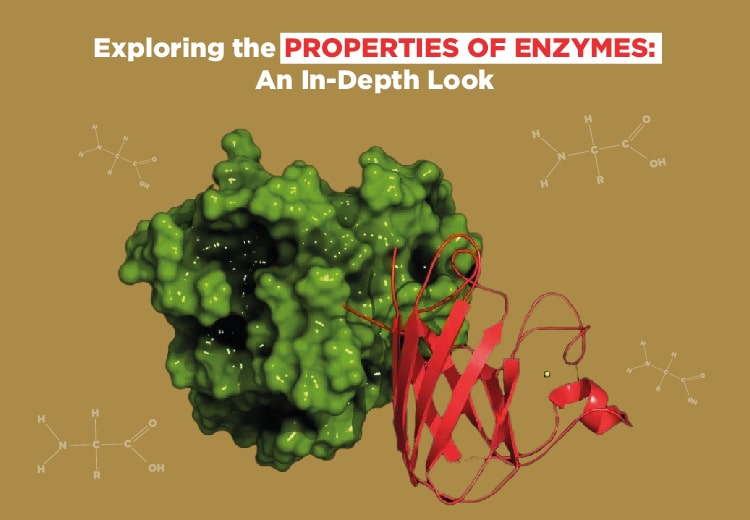
Enzymes help things happen quickly and keep quality good in our fast-paced world. We are exploring the properties of enzymes in this blog to better know how they work, what they do, and how we can use them. Numerous biological processes heavily rely on enzymes, often referred to as nature’s catalysts. Enzymes play a crucial role in many important activities in living things. These include breaking down food, making new cells, and creating proteins and DNA. Now, let’s begin by discussing the properties of enzymes.
What are the properties of enzymes?
Remember the Properties of Enzymes we learned in class 11. They act as catalysts to make reactions faster. Enzymes are special because they only react with certain things that fit their shape. They recognise these things based on the shape of their active site. They create transient enzyme-substrate complexes that help turn substrates into products. Through genetic, post-translational, and allosteric processes, enzyme activity is carefully controlled. Enzymes work best when all their active sites are filled with substrate. This is called saturation kinetics. They work best at certain temperatures and pH levels. Enzymes are like helpers that make chemical reactions happen faster in our bodies. They do this by lowering the energy needed for the reaction to take place. By binding to particular substrates at their active sites, they demonstrate specificity. Enzymes are protein-based and catalyse reactions by forming transient enzyme-substrate complexes. Temperature and pH sensitivity make for ideal settings for the activity. In addition to being extremely effective and recyclable, enzyme activity can be controlled. Reaction rates are influenced by enzyme concentration and saturation kinetics. To understand how enzymes work in biology and their different uses, you need to know some basic things about the general properties of enzymes. Having explored the important and general properties of enzymes, let us now delve into their features and applications. Enzymes have important properties. Now, let’s look at their features and uses. Understanding enzymes help us use them in medicine and industry.
Enzyme Structure:
Although some RNA molecules can also display enzymatic activity, enzymes are primarily proteins. They have a three-dimensional structure that enables them to properly perform their duties. The levels of organisation at which an enzyme is organised can be categorised as primary, secondary, tertiary, and quaternary. By attaching to the substrate, the active site, a section of the structure of the enzyme, is essential for catalysing particular processes.
Enzyme Function:
By reducing the activation energy necessary for the reaction to continue, an enzyme’s main job is to speed up the rate of a biological reaction. This is accomplished by enzymes generating transient enzyme-substrate complexes that aid in the transformation of substrates into products. The ability of an enzyme to recognise and bind to a particular substrate because of the complementary form of the active site is known as specificity.
Enzyme Kinetics:
On the other hand, the study of the speeds of enzymatic reactions and the variables that affect them is known as enzyme kinetics. It investigates how changes in temperature, pH, substrate concentration, enzyme concentration, and the presence of inhibitors or activators affect the rate of an enzymatic process. Enzyme kinetics sheds light on the quantitative facets of enzyme activity as well as the mechanics of enzyme-catalyzed reactions.
Enzyme Regulation:
On the other hand, the study of the speeds of enzymatic reactions and the variables that affect them is known as enzyme kinetics. It investigates how changes in temperature, pH, substrate concentration, enzyme concentration, and the presence of inhibitors or activators affect the rate of an enzymatic process. Enzyme kinetics sheds light on the quantitative facets of enzyme activity as well as the mechanics of enzyme-catalyzed reactions. This Enzyme kinetics shows how enzymes work and what factors affect them. Many things can change how enzymes work. Enzymes work differently depending on their surroundings. Things like temperature, pH levels, and whether there are any inhibitors or activators can affect their activity.
Industrial Applications of Enzymes
Enzymes have enormous practical uses in industries. Enzymes are used a lot in making medicine, detergents, food and drinks, and some other industries too. Genetic illnesses caused by enzyme deficiencies are treated with enzyme-based therapies, like enzyme replacement therapy.
You can also read:: Different Types of Enzymes That Are Used In Textile Industry & Food Industry
Conclusion
Enzymes have amazing qualities that make life possible. We saw the properties of enzymes and how they are used in different industries. These remarkable macromolecules play a vital role in our world. To appreciate what happens inside living things, it is important to understand how they work and are controlled. By studying and using enzymes, we can find ways to make our lives better with more science and technology. At Ultreze Enzymes, we make excellent enzymes that the industry needs. Our enzymes are high quality and affordable. We make and sell enzymes like Alpha-Amylase and Beta Glucanase for different industries, including pharmaceuticals, textiles, food and beverages, animal feed, sugar, and starch processing, detergents, paper and pulp, and distilleries. If you need quality enzymes for your industry, contact us now!


